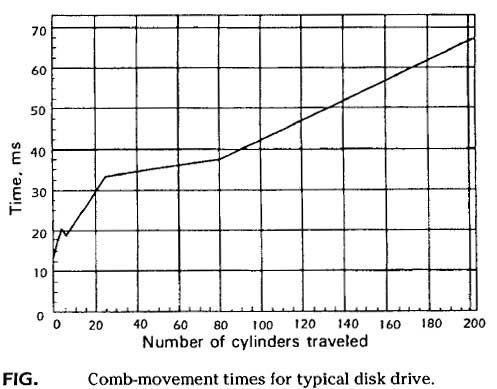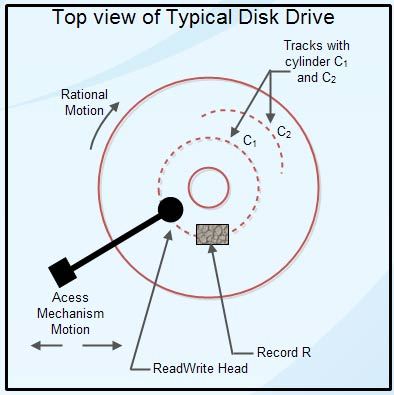Hard Disk Access time is the total elapsed time between the initiation of a particular request for data and receipt of the first bit of that data.
Direct access devices (Hard Disk Drive) require varying times to position a disk head over a particular record. In the case of a moving-head disk drive, this involves positioning the comb (head assembly, as in Fig.) to the designated cylinder, plus rotation of the selected track to the desired record. Comb-movement times for a typical medium-sized disk drive are shown in Fig.
For a disk, total access time is the sum of comb-movement and rotational times to reach a particular record (plus the time to switch from reading or writing one surface to another, but, since this is done at electronic speeds, it contributes almost nothing to the access time). There is a different access time for each record retrieved at random from a disk drive, since it is necessary to move from cylinder C1 to cylinder C2 (Fig.), and then await rotational positioning of record R.
Suppose the disk drive, whose comb-movement time is shown in Fig, rotates at 3,600 rpm, which is equivalent to 16.7 ms per rotation. Then the maximum access time for this device is 87 ms (70 ms for the comb movement, plus 17 ms for the rotation), the average access time is about 43 ms (35 + 8) and the minimum access time is 12 ms. The latter time, which is the time required to move the comb to an adjacent cylinder is also called the track-to-track access time. Of course, if successive records are on the same cylinder, the access time can be zero.
Average access time is an important parameter for analytical planning of a real-time computer application, e.g. an on-line inquiry system. Minimum access time is more important for sequential usage of disk drives. The dominant component of delay for sequential retrieval of records from a disk drive is the average time for a half-rotation (8.3 ms for the drive described in Fig).
During the past 30 years, rotational speeds for hard disk drives have improved relatively little: 3,600 rpm is typical. But bit densities per track have increased fivefold in this same period, so that average transfer speeds have increased even if track-to-track access times have not diminished. During this period, average access times have been halved as a result of a widespread changeover from hydraulic actuators to “voice coil” actuators for moving the comb mechanism.


For a floppy disk drive, the average access time is 25 ms; the access times for compact disc read-only memories (CD-ROMs)are approximately twice as long as for floppy disks. For a drum or fixed-head disk, average access time is a half-revolution and maximum access time is a full revolution, since both have heads that are fixed over the data areas. Average access times for drums are 5 to 10 ms.

For “honeycomb” lattices of videotape cartridges and similar mass storage systems, average access times depend on movement of the medium to a read/write head. For tape-cartridge mass storage systems, average access time is approximately 15sec and minimum access time to a new cartridge is approximately 12 sec.
 Dinesh Thakur holds an B.C.A, MCDBA, MCSD certifications. Dinesh authors the hugely popular
Dinesh Thakur holds an B.C.A, MCDBA, MCSD certifications. Dinesh authors the hugely popular